How to Determine your Intraocular Lens Implant (IOL)
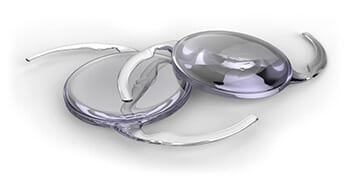 An important part of your pre-operative process will involve choosing a lens implant that is right for your personal lifestyle. Some people do more reading or have hobbies that involve near vision tasks as others may enjoy driving or traveling who demand better quality distant vision. Then there are people who seek a full range of vision with the least dependence on glasses or contacts.
An important part of your pre-operative process will involve choosing a lens implant that is right for your personal lifestyle. Some people do more reading or have hobbies that involve near vision tasks as others may enjoy driving or traveling who demand better quality distant vision. Then there are people who seek a full range of vision with the least dependence on glasses or contacts.
For years The Eye Institute of West Florida has successfully restored vision for thousands of patients. As technology improves, so do vision results. The art and skill of our cataract specialists helped improve operating methods that have physicians around the world now using the same micro-incisional technique pioneered at The Eye Institute.
Additionally, technology has improved vision by creating implantable replacement lenses that allow the eye to focus. It wasn’t until the 70’s that the use of plastic lenses actually became widespread and, through the advent of modern lens technology, scientists have produced some of the most amazing lens options used today. At The Eye Institute, we are committed to providing our patients with the latest lens options for the best possible results.
What makes The Eye Institute of West Florida unique is the philosophy of being on the cutting edge of all technologies. This means our physicians are not beholden to any manufacturers and utilize the best products for our patients.
Surgical Implantation
Whether you are having a standard lens implanted or opt for a premium option, the surgical process is the same. Once your eye is numbed and dilated and you are given medication to help you relax, you will receive a painless incision of less than 2mm into the clear cornea of your eye by your surgeon or a laser. Once the incision is made, the cataract is broken into microscopic particles using ultrasonic waves and then gently removed from the eye (phacoemulsification process). Then the lens selected especially for you is implanted to replace the natural lens. If you have astigmatism (irregularity in the shape of the eye) it too can be treated during surgery to ensure better vision without glasses. The incision is usually self-sealing so that no stitches are needed. There is generally no pain and no patch and you can return home immediately.
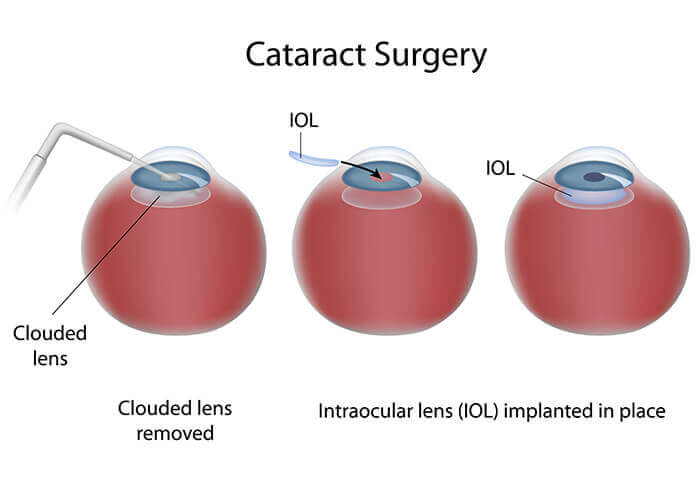
What are the different types of lens implants?
The implantation procedure is the same for both types of IOLs. The main point of differentiation between the IOLs is in the type of vision they provide. Please click on the option below to learn more about the different intraocular lenses (IOLs).
Aspheric or non-speherical intraocular lenses differ in a big way to traditional intraocular lenses. Traditional IOLs have a spherical design which makes the front surface uniformly curved from the center to the rim of the lens. Aspheric lenses more closely mimic the the shape of the natural lens of the eye.
This distinction is important because spherical lenses can create minor problems in vision called higher-order aberrations or HOAs. This can make low-light conditions such as driving at night an issue. Premium aspheric IOLs are a great way to combat this issues by providing sharp vision in low light conditions and for people with large pupils.
Aspheric Lens Options:
- Johnson & Johnson Vision – Tecnis IOL
- Alcon – AcrySof IQ
- Bausch + Lomb – enVista
Toric lens implants are used to correct astigmatism, an optical irregularity caused by a football-shaped curvature of the cornea. Astigmatism may occur in varying degrees in each eye and can be present in addition to myopia, hyperopia, and presbyopia. For those with uncorrected astigmatism, images will look blurry, and sometimes shadowed. Astigmatism is very common.
Toric lens implants have been providing those with astigmatism a way to correct astigmatism without glasses or contacts. This creates less hassle, and glasses or contacts will no longer interfere with things such as driving and physical activity. If you have astigmatism, you understand how frustrating it can be to deal with blurry vision when trying to carry out everyday activities.
A great thing about toric lenses is that they can be used to replace a cataract-affected natural lens. If you have astigmatism, and you also need a cataract removed, you can correct both conditions at once using the toric lens implant. Our doctors at Eye Institute of West Florida are highly experienced in lens implants and want to make sure you are making the best decision possible for your vision.
Toric Lens Options:
- Johnson & Johnson Vision – Tecnis Toric
- Alcon – AcrySof IQ Toric
- Bausch + Lomb – enVista Toric
Accommodating IOls use the natural muscles of the eye allowing the lens to flex inside the eye so patients see well at a distance and mid-range, as well as for some up-close tasks.
One of more recent innovations in cataract lens technology is the accommodative intraocular lens (IOL). These premium implants, like the new Crystalens by Bausch & Lomb, have patients experiencing incredible vision at all ranges thereby minimizing the need for eyeglasses for most activities, including reading, computer and driving. Like your natural lens, the Crystalens uses eye muscles to flex and “accommodate” in order to focus on objects in the environment at all distances. Crystalens dynamically adjusts to your visual needs. By comparison, a standard implant lens only allows the eye to focus at one distance (typically distance vision) whereas a premium lens focuses at all ranges of vision – up close, intermediate and distance.
Unfortunately, accommodative lenses are not for everyone. Your doctor will help determine if you are a candidate for one of these premium lenses. Call today to make an appointment for your cataract consultation.
Advanced Intraocular Lens (IOL) Options
Many brands have emerged in the market of multifocal lenses. At The Eye Institute, we help you select the right lens that will best match your lifestyle. We understand the impact of quality vision and want the very best for you should you be a candidate. Two particular lens options you may have heard of are the Crystalens and RESTOR.
Crystalens
The Crystalens AO lens represents the 4th generation of advancement in intraocular vision correction technology and is the only accommodative implant approved by the FDA. It actually flexes inside the eye like a healthy, natural lens to focus light rays on the retina. Crystalens AO is the only vision solution that works with the eye muscles to provide a complete range of sight from near to far and all distances in between – reducing or possibly eliminating the need for glasses. Crystalens’ unique “hinges” allow the lens to move or accommodate in response to the contraction of the eye muscles of accommodation.
Crystalens is designed for patients who desire the following:
- Desire sharp distance vision both day and night
- Good computer vision without glasses
- Fair to good near reading vision
- Reduced night time halos and glare
- The RESTORIOL is a unique technological innovation that can provide the quality vision for near, intermediate and distance vision by combining the strengths of apodized diffractive and refractive technologies.
The RESTOR IOL is indicated for patients who desire the following:
- Excellent distance vision
- Excellent reading vision
- Designed for heavy readers
- Patients may need a slight prescription for intermediate or computer tasks and experience some glare and halos at night.
Accommodating Lens Options:
- Bausch + Lomb – Crystalens AO
- Bausch + Lomb – Trulign Toric IOL
- Alcon – AcrySof IQ ReSTOR IOL
Multifocal lenses offer the latest in innovative premium IOLs available. These lenses are designed to give patients natural vision and the most freedom from glasses after cataract surgery. Multifocal IOLs use a ring pattern design much like trifocal glasses, to provide vision at every range of distance. Multifocal lens implants are premium lens implants that provide vision at all ranges without the need for glasses all the time. Should you be a candidate for a multifocal or premium lens implant, our physicians will talk to you about lens options that match your lifestyle.
Multifocal Lens Options:
- Johnson & Johnson Vision – Tecnis Multifocal IOL
- Alcon – AcrySof IQ ReSTOR Multifocal IOL
The AcrySof IQ PanOptix IOL is an intraocular lens designed to provide you with clear vision for near, intermediate, and far distances without glasses. For this reason, it is sometimes called a “trifocal” lens much like the trifocal prescription you would get with conventional glasses. This premium IOL is designed to reduce or eliminate your need for glasses after cataract surgery at all ranges of distances.
What makes the PanOptix IOL unique is its ability to mimic a young eye. The design of the lens does this by bending light rays to allow them to focus on the retina (the back surface of the eye) in all distances. Examples of crisp vision at near vision include reading a book, using a cellphone or reading a menu; at intermediate vision include using a computer, playing board games, or looking in the mirror; at distance vision include watching TV, driving, playing golf, or attending sports and concert venues.
Trifocal Lens Options:
-
Alcon – AcrySof IQ PanOptix Trifocal IOL
Dr. Robert Weinstock, Director of Cataract and Refractive Surgery at The Eye Institute of West Florida, is the first surgeon in the southeastern United States to use this innovative technology. The Light Adjustable Lens (LAL) is the first of its kind. The lens gives our surgeons the ability to make adjustments to the lens after implementation in a series of brief, painless in-office procedures.
RxSight’s Light Adjustable Lens is the only IOL that enables you to design, trial and customize your vision after cataract surgery. Adjustability takes cataract surgery to the next level by giving you a lens customized specifically for your eyes! In an FDA study of 600 subjects, those who received the Light Adjustable Lens were twice as likely (as those who received a standard monofocal IOL) to achieve 20/20 vision without glasses.
The U.S. Food and Drug Administration has approved the Light Adjustable Lens and Light Delivery Device for patients with pre-existing astigmatism of 0.75 diopters or more who are undergoing cataract surgery. Ask our doctors to explain the possible risks and benefits of cataract surgery.
How the Light Adjustable Lens (LAL) Works
The Light Adjustable Lens is made of a special photo-sensitive material that changes the power of your implanted lens in response to UV light, increasing the likelihood that you will achieve your desired vision after cataract surgery.
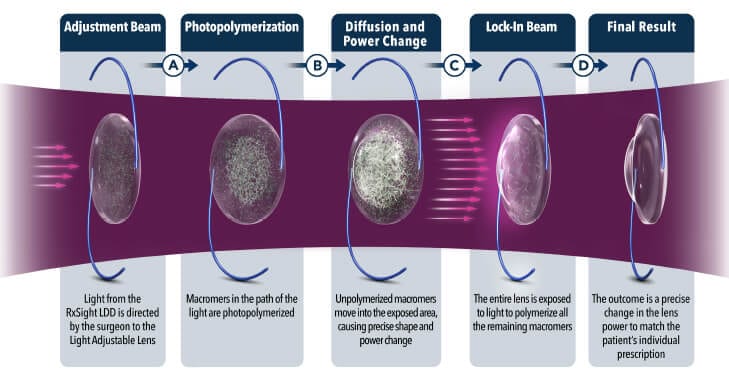
After Cataract Surgery
As the Light Adjustable Lens is post-operatively adjusted to deliver customized vision, there are two major differences in the period after cataract surgery.
Required wear of (UV) protective glasses |
Completion of light treatments |
 |
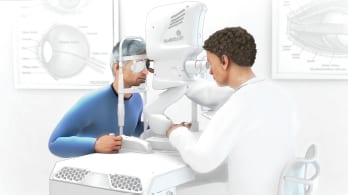 |
UV Protective Glasses
The sun is the primary natural source of UV light, and artificial sources of UV light are safely used in many medical and ophthalmic treatments. However, as exposure to indoor and outdoor sources of UV light can cause uncontrolled changes to the Light Adjustable Lens – you will be provided with UV protective glasses to wear during all waking hours (from time of lens implantation until after the last light treatment is completed). Glasses may be removed when sleeping, and maybe temporarily removed when showering, washing your face, or applying eye drops as long as you are not exposed to direct sunlight. 24 hours after the final light treatment, no further changes can be made to the implanted Light Adjustable Lens, and you can remove the UV protective glasses and enjoy your custom vision!
How the Light Treatments are Performed
What is unique about the Light Adjustable Lens is that, after your eye heals, you return to your eye doctor to have your vision tested during a routine eye exam. Based on this exam, you and your doctor will select a custom prescription for your adjustable lens based on your own eyes and unique lifestyle requirements. To receive the light treatment, you will be placed in front of RxSight’s Light Delivery Device, which will non-invasively deliver the UV light to your Light Adjustable Lens.
Light Treatments
Between 2 and 4 total light treatments, each lasting approximately 90 seconds and separated by approximately 3 days, are required. The total number of light treatments is based on the achievement of you and your doctor’s desired outcome.
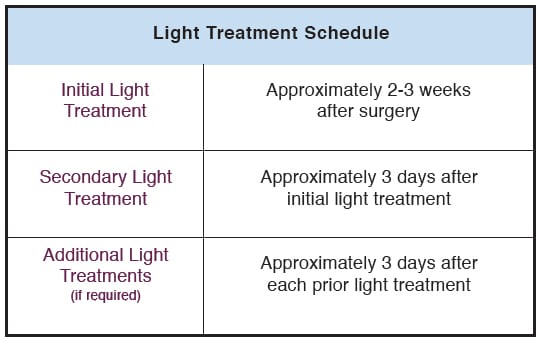
Adjustable Lens Options:
- RxSight – Light Adjustable Lens
Getting older can mean lots of things: creaky joints, wrinkles, and the loss of your full range of vision. For those that suffer from both presbyopia and cataracts, a new IOL on the market called the Tecnis Symfony IOL is a great treatment option. The Symfony is truly the first of its kind, because it’s able to treat both cataracts and presbyopia, and improves distance vision at the same time. Unlike traditional IOLs, the Symfony also only leaves clear vision in its wake, instead of glare and halos around lights.
Am I A Good Candidate For The Tecnis Symfony IOL?
The Tecnis Symfony IOL is an intraocular lens that’s ideal for patients who are already looking to undergo cataract surgery. Like in traditional cataract surgery, the Symfony IOL is inserted into the eye and replaces the aged natural cataract lens in the eye. The Symfony is used to replace the cataract, leaving clear vision. Many patients find that they can see clearly almost immediately after the surgery is completed, though it does depend on the patient. Full results of the Symfony IOL are achieved after recovery and healing are complete.
In addition to many patients improving their full range of vision, a big advantage of the Symfony is that the need for reading glasses is usually almost eliminated. During traditional cataract surgery, standard lenses are used, which cannot change the need for glasses. This leaves patients with clearer vision, along with a life that is free of reading glasses. The Symfony IOL is also able to improve vision at all distances for patients, which the standard lenses used in cataract surgery also cannot do.
How Do I Receive The Tecnis Symfony IOL?
Because the Symfony IOL is relatively new, many practices in America may not be offering it for patients who suffer from presbyopia and cataracts. The Eye Institute of West Florida is happy to announce that we are now offering this revolutionary new technology for our patients. Please contact us for more information, and to set up an appointment for a cataract surgery consultation.
The Symfony IOL is an innovative new lens, but it may not be the right procedure for everyone. Before scheduling cataract surgery, it is important to talk to your doctor to make sure cataract surgery is right for you. If you suffer from the debilitating effects of presbyopia and cataracts, the Tecnis Symfony IOL could be the next step on your journey to clear vision.
Extended Range of Vision Lens Options:
- Johnson & Johnson Vision – Tecnis Symfony IOL
Monofocal is a lens that is specifically designed for one range of vision, either distant or up close. Your surgeon will help you obtain the clearest vision possible to suit your vision needs. With monofocal lenses, glasses or contacts may be needed after surgery. Also, should you have astigmatism, glasses will be needed to correct it unless the astigmatism is corrected at the time of surgery.
Monovision is a selection of lenses that allow one eye to see up close and the other eye to see at a distance. This coordination of lenses allows the brain to focus clearly on objects close up, as well as far away. Monovision is not for everyone and works well for patients who previously used monovision contacts.
Part of the IOL selection process will be determined by whether or no you have astigmatism. If you have astigmatism and you are tired of the hassle of glasses and contacts, call us to schedule an appointment. One of our great doctors will examine your eyes to determine which method of correction best suits you! Don’t wait, take back your vision today at the Eye Institute of West Florida!
Schedule your Cataract Evaluation today
Call (727) 581-8706 to schedule your appointment
*Not all patients are candidates for premium IOLs. Your doctor will let you know what IOL options you are a candidate for.
Meet Your Cataract Care Specialists
 Stephen M Weinstock, M.D., F.A.C.S., is a cataract and LASIK specialist. He founded The Eye Institute of West Florida in 1974, pioneering sub-specialty eye care in Pinellas County. Today, as President and Medical Director, Dr. Weinstock is recognized as a world renowned cataract and LASIK surgeon. He teaches the latest techniques such as”no-stitch, no-patch” cataract extraction and implantation of premium intraocular lenses (IOLs), here and abroad. Dr. Weinstock is also very proud of being the first ophthalmologist to introduce the excimer and YAG lasers to Pinellas County.
Stephen M Weinstock, M.D., F.A.C.S., is a cataract and LASIK specialist. He founded The Eye Institute of West Florida in 1974, pioneering sub-specialty eye care in Pinellas County. Today, as President and Medical Director, Dr. Weinstock is recognized as a world renowned cataract and LASIK surgeon. He teaches the latest techniques such as”no-stitch, no-patch” cataract extraction and implantation of premium intraocular lenses (IOLs), here and abroad. Dr. Weinstock is also very proud of being the first ophthalmologist to introduce the excimer and YAG lasers to Pinellas County.
In 1999 for his outstanding performance as a refractive surgeon, Dr. Weinstock was honored with the”VISX Star Surgeon” award and placed in the top 5% of refractive surgeons nationwide. He is one of the only surgeons in the country who has been certified by the American Board of Eye Surgery in both Cataract and LASIK surgery.
Dr. Weinstock is also an associate clinical professor of ophthalmology at the University of South Florida.
 Robert J. Weinstock, M.D. is a board-certified ophthalmologist and is fellowship-trained in cataract and refractive surgery. He became interested in ophthalmology at an early age – as he watched and assisted his father. Dr. Weinstock has joined the practice in 2001 after completing his residency at the St. Louis University School of Medicine.
Robert J. Weinstock, M.D. is a board-certified ophthalmologist and is fellowship-trained in cataract and refractive surgery. He became interested in ophthalmology at an early age – as he watched and assisted his father. Dr. Weinstock has joined the practice in 2001 after completing his residency at the St. Louis University School of Medicine.
He is the Director of Cataract and Refractive Services at the Eye Institute of West Florida and The Weinstock Laser Eye Center. He also is an associate clinical professor of ophthalmology at the University of South Florida, and serves as the Surgical Director of the Largo Ambulatory Surgery Center. He was named one of 250 in Permier Surgeon’s List of Leading Innovators of 2010 for his contributions to cataract surgery and premium IOLs. In addition to performing thousands of vision correcting cataract and LASIK procedures each year, Dr. Weinstock speaks and teaches nationally and internationally on customized cataract surgery and surgical innovations. He is continuously engaged in clinical research and studies to evaluate new technology, many of which are sanctioned by the FDA. He is recognized internationally as an expert on new implant technology and microincisional surgical techniques. He has authored many book chapters on cataract surgery and continues to write journal articles on cataract and refractive surgery.
 Neel R. Desai, M.D. is a fellowship-trained ophthalmologist strictly specializing in LASIK, cataract and corneal diseases of the eye. Dr. Desai is a top graduate of the Pennsylvania State University College of Medicine and completed his fellowship in cornea, cataract and refractive surgery at the Wilmer Eye Institute at Johns Hopkins University. He is recognized throughout the country and internationally as one of only 100 surgeons able to perform advanced corneal transplants and other complex cataract, corneal and refractive procedures. He holds pending patents to new surgical products and advanced cornea surgical procedures of his own design. Additionally, Dr. Desai has authored many book chapters in his field of study and continues to write articles in peer review journals.
Neel R. Desai, M.D. is a fellowship-trained ophthalmologist strictly specializing in LASIK, cataract and corneal diseases of the eye. Dr. Desai is a top graduate of the Pennsylvania State University College of Medicine and completed his fellowship in cornea, cataract and refractive surgery at the Wilmer Eye Institute at Johns Hopkins University. He is recognized throughout the country and internationally as one of only 100 surgeons able to perform advanced corneal transplants and other complex cataract, corneal and refractive procedures. He holds pending patents to new surgical products and advanced cornea surgical procedures of his own design. Additionally, Dr. Desai has authored many book chapters in his field of study and continues to write articles in peer review journals.

